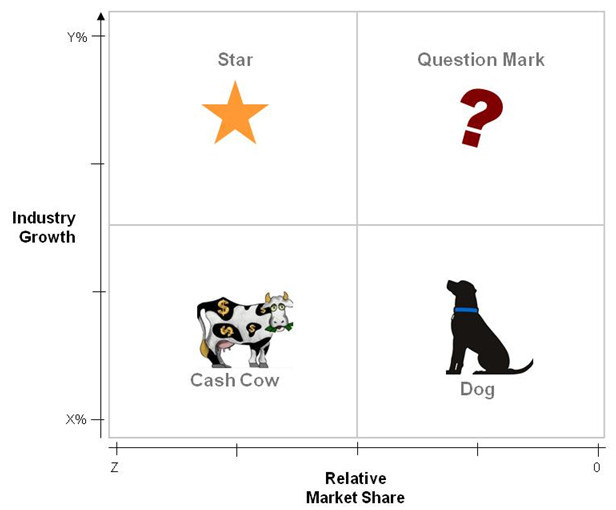The BCG Growth Share Matrix is a simple but powerful conceptual framework for businesses, large and small. It is still very much applicable today, and well worth mastering for strategic portfolio managers, project portfolio managers, program managers, and project managers.
This post provides an introduction to the BCG Growth Share Matrix Diagram, digs into the detail of each element, and reviews impacts to strategists and project managers.
Origin and Basics of the BCG Growth Share Matrix Diagram
 The BCG Growth Share Matrix, also sometimes called the product portfolio or Boston matrix, was developed in 1968 by Boston Consulting Group (BCG) founder Bruce Henderson. It was used heavily for many years by a large portion of international conglomerate corporations as part of strategy efforts. It remains a foundational staple in MBA strategy courses.
The BCG Growth Share Matrix, also sometimes called the product portfolio or Boston matrix, was developed in 1968 by Boston Consulting Group (BCG) founder Bruce Henderson. It was used heavily for many years by a large portion of international conglomerate corporations as part of strategy efforts. It remains a foundational staple in MBA strategy courses.
The matrix is similarly structured, is derived from similar thinking, and overlaps in some ways with some old core BCG frameworks such as the BCG Advantage Matrix, Experience Curve, and the Rule of Three and Four.
The visual, shown at right, depicts a continuum along two dimensions:
- Market share – This is the share of the market for a specific product, service, or grouping that is competing directly with other offers of closely similar items. The more to the right on the graph – lower the market share – the more you move from Star and Cash Cow to Question Mark and Dog territory (quadrants).
- Growth – Some industries are stable or even declining, and some are growing, albeit at a whole range of growth rates. As you move from bottom to top, you move from slow (sometimes even negative) growth to high growth. As you move up, you move from the Cash Cow and Dog quadrants to Star and Question Mark territory.
In looking at the BCG Growth Share Matrix Diagram, it is essential to understand your context in terms of the product life cycle and industry stage. With that understanding, the diagram can help to allocate resources for strategic portfolio development, project portfolio management, and as an analytical tool for brand management.
Let’s look in more detail at the components of the matrix.
Four Quadrants of the BCG Growth Share Matrix Diagram
Thinking about the vertical axis in the graph as Market or Industry Growth (MIG) and the horizontal axis as Relative Market Share (RMS), here is how the four quadrants are defined:
- Cash Cow – MIG is low, and RMS is high. Thus, a Cash Cow line of business has a high market share but is in a slow growing industry or market. It generates excess cash, and thus can be “milked” (hence the name Cash Cow) to finance growth businesses that need cash.
- Star – MIG is high, and RMS is high. A Star business is in a strong position, based on a high market share in a growth industry or market, to later become a Cash Cow. Because of the high current market share, the business is already generating excess cash.
- Question Mark – MIG is high, and RMS is low. Sometimes also referred to as a Problem Child, Question Mark businesses are in high growth industries or markets but have not, at least not yet, established themselves as market leaders. They require cash to grow, and they require the most attention strategically to distinguish whether they can become tomorrow’s Cash Cows or Dogs.
- Dog – MIG is low, and RMS is low. Sometimes also called Pets, Dogs generate neither cash nor growth. If there is no other benefit to the business – i.e. network, market position, social posture – it may be advisable to divest or close the business.
The whole framework is fundamentally about cash flow, where older, more stable, and well-established businesses produce the cash flow to finance high growth businesses for having a productive, balanced, and sustainable enterprise.
Strategic Application of the BCG Growth Share Matrix Approach
Strategically, an enterprise might like to strive to have a portfolio that consists of a good blend of businesses consisting of all four types represented in the matrix. This may be a worthy objective for large, diversified businesses, but what about small growing ones?
One perspective is to think beyond, or outside of, the current organization. For example, many technology companies focus on developing a technology – using financing to move up the experience curve and later sell to a large buyer that will roll it into their portfolio of businesses.
Another perspective is for enterprises, in the face of increasingly short business cycles, to consider growth share concepts as part of their portfolio of increasingly short-lived businesses. Managing through shorter business cycles, where businesses compete more in ‘arenas’ that industries, is the practice of strategic agility.
The BCG Growth Share Matrix approach in the past was mainly used by large enterprises. Today it is also driven, in major part, by the network effects, which were not even a factor when the Growth Share Matrix idea was formulated.
Project Impact of the BCG Growth Share Matrix Approach
Portfolio, program, and project managers can leverage the growth share matrix in the following ways:
—————————————-
I recommend these PM templates (paid link):
—————————————-
Portfolio Management – In constructing the portfolio of projects, portfolio managers need to keep in mind the same concepts as business portfolio strategists. What projects are most likely to generate cash? Which will consume cash and not yield business results until later? Which are supporting an existing low growth business? What kind of balance are we trying to achieve across the portfolio of projects?
Program Management – Where a program will likely support a particular line of business, it will be helpful to understand the context of the business supported. Is it supporting a growth business? A business in transition? A Question Mark situation? The answers to these questions will provide some perspective on the way ahead.
Project Management – Like program and portfolio managers, perspective makes a difference. The key question is, what metrics will tell us if we are achieving the targeted strategic objectives? These metrics will be shaped in part by where the business supported fits into the BCG Growth Share Matrix Diagram.
Further Resources
A great way to build a strong portfolio of businesses for the future is to apply Blue Ocean thinking. See our posts on the Blue Ocean Strategy and Blue Ocean Leadership, and go directly to the Blue Ocean Strategy website.
The following are related resources (these are paid links):



